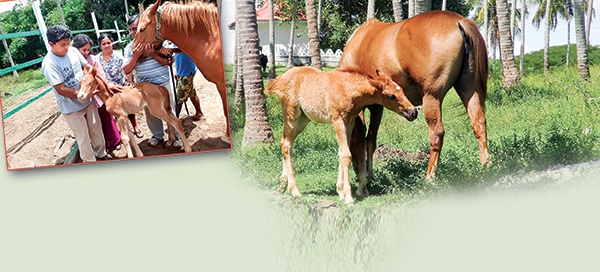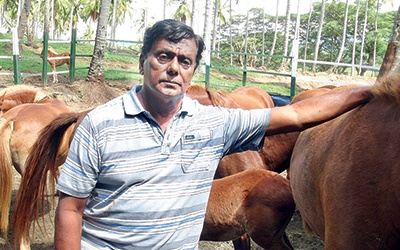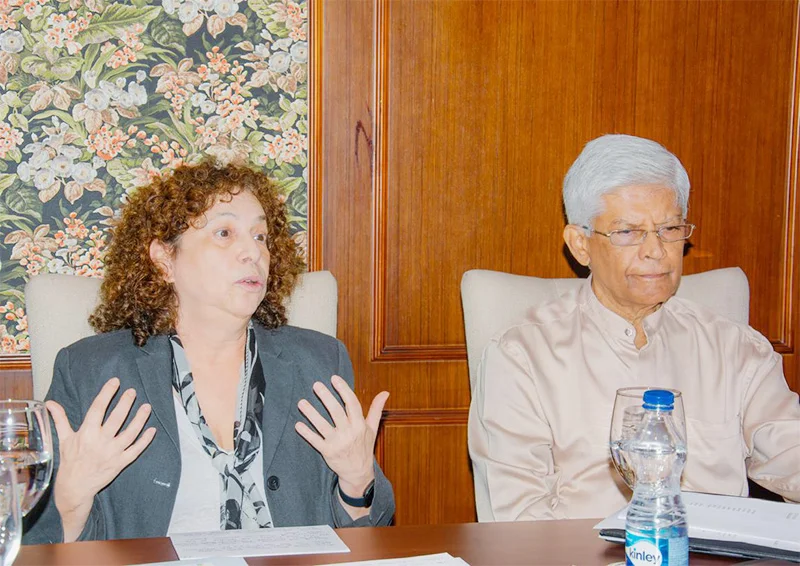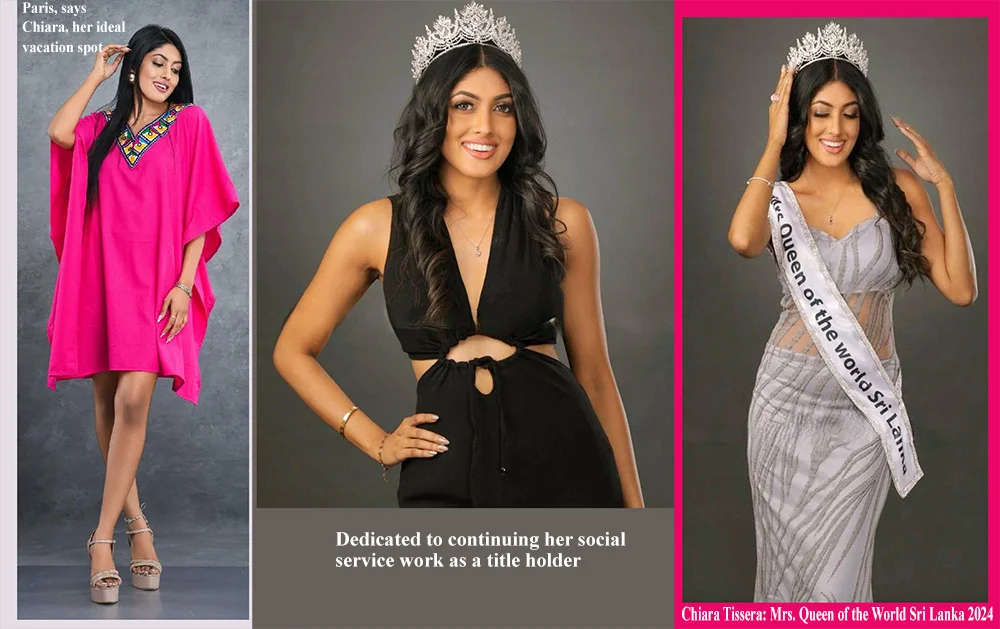Features
Samantha, a labour of love

First artificially inseminated foal in Sri Lankan
By Sajitha Prematunge and Lalantha Wanniarachchi
Tall and stout by Sri Lankan standards, Samantha, was quite oblivious to her historical significance. She is the first artificially inseminated foal in Sri Lanka. From the former Director of Forestry and Environment Division, Mahaweli Authority turned breeder, Palitha Samarakoon, who tried to get mare Thulvaan to conceive but in vain, to the veterinary team at Peradeniya University, Veterinary Science Faculty, the coming of the now happy and healthy filly was something akin to childbirth. Samantha was the culmination of years of hard work and months of anxious anticipation.
A casual conversation with Peradeniya University, Veterinary Science Faculty, Senior Lecturer Prof Basil Alexander convinced Samarakoon that artificially inseminating a mare was not altogether impossible. Ten doses of semen, of Arabian pedigree, were brought from a stud farm in California at Rs 100,000 each. Thulvaan of the seventh generation from Upali Wijewardene’s stock was the ideal candidate.
Veterinary marvel
The insemination was professionally carried out by Senior Lecturer Dr Dammika Perera together with Alexander and Anil Pushpakumara of the Veterinary Science Faculty. Of course, a straightforward artificial insemination, as that of Samantha’s, was probably a cake-walk for a Department that introduced to Sri Lanka, technologies such as embryo transplantation to create high standard cattle over a decade ago. While a cow gives birth to an average of eight to 10 calves during her lifetime, they have thousands of eggs in their ovaries. In a bid to utilise the maximum reproductive potential of genetically superior female animals with high milk production capacity, multiple embryos harvested from such cows were transferred to recipient cows to complete gestation.
 “The technology allows us to get up to 200 calves from a cow that would have had only eight in its lifetime, under natural circumstances,” said Dr Dammika Perera. He explained that artificial insemination allowed the selection of superior paternal genetic material, but the embryo transfer technique facilitates selection of both superior maternal and paternal genetic material. “The technology can be further developed by splitting an embryo to get two calves,” said Perera. The faculty also devised a method with which live embryos could be stored in liquid nitrogen. “Having a ready supply of embryos allows farmers to time the births according to their milk production requirements and availability of resources such as grazing grounds.”
“The technology allows us to get up to 200 calves from a cow that would have had only eight in its lifetime, under natural circumstances,” said Dr Dammika Perera. He explained that artificial insemination allowed the selection of superior paternal genetic material, but the embryo transfer technique facilitates selection of both superior maternal and paternal genetic material. “The technology can be further developed by splitting an embryo to get two calves,” said Perera. The faculty also devised a method with which live embryos could be stored in liquid nitrogen. “Having a ready supply of embryos allows farmers to time the births according to their milk production requirements and availability of resources such as grazing grounds.”
However, Dr. Perera explained that artificially inseminating a mare was a novel experience. “The mare has to be in heat for the egg to be fertilised. We had to prime the womb with hormone treatment for maximum effect,” Perera explained the process. “Then we had to make sure she was in fact in heat by looking for signs such as changes in the vaginal opening and passage.” According to Perera, cervical tone has to be monitored and hormone treatment continued till desired tone is achieved. Ultrasound scans of the uterus, examination of ovaries, regular scans to monitor egg diameter and further hormone treatment to bring eggs to the desired size are all a part of the artificial insemination process.
“It is only after ensuring that everything is satisfactory that we take the sperm out of cold storage, bring it down to room temperature and inseminate the mare.” This is followed by further hormone treatment and scans at 12-hour periods. “By the 15th day we can determine whether the mare has successfully conceived. Scans are done at the end of the first and second trimesters to monitor the growth of the foetus, identify any abnormalities and interventions to rectify such abnormalities, carried out.”
Dr. Perera is treading unfamiliar territory. Consequently, his job requires critical thinking and a certain amount of derring-do, as it were. He admitted that although veterinarians must be aware of all the state-of-the-art research in the field, foreign research was not directly applicable to a country like Sri Lanka due to geographical and climactic differences. “Some are economically not viable. Research can’t be undertaken lightly because that would lead to waste of valuable resources. It has to be targeted at finding what works for our country.”
The gestation period of a mare is 11 months and 15 days, give or take 15 days more, said Samarakoon. But Samantha, being of good pedigree, consequently quite well-developed, was a feisty one and Thulvaan was forced to deliver 15 days ahead of schedule.
Animal lover
Samarakoon became the proud owner of a cow on his seventh birthday, when his mother bought it for him from an auction at the Kundasale farm for Rs. 80. Thus began his love for animals. He later graduated to elephants and crocodiles, but it goes without saying that he had a soft spot for horses. Samarakoon joined the Mahaweli Authority in 1979. He believed that having hands on experience was vital for him to perform his duties as the Director of Forestry and Environment Division. Samarakoon was responsible for successfully completing a 12 million tree planting project, a feat not achieved by any department since. “But to this day no one has expressed interest in acquiring that knowledge,” said Samarakoon, ruefully.
 After Upali Wijewardena disappeared his stables were up for offer. Seeing Samarakoon was a true animal lover, Chairman of the Upali Group, Dr. Seevali Ratwatte gifted all 12 horses to Samarakoon in 1983. The late Gamini Dissanayake extended Samarakoon the support necessary to make it an official breeding programme under the Mahaweli Authority banner.
After Upali Wijewardena disappeared his stables were up for offer. Seeing Samarakoon was a true animal lover, Chairman of the Upali Group, Dr. Seevali Ratwatte gifted all 12 horses to Samarakoon in 1983. The late Gamini Dissanayake extended Samarakoon the support necessary to make it an official breeding programme under the Mahaweli Authority banner.
Breeding a stock that were originally groomed for racing proved difficult as no records on their breeding capacity existed and there was a shortage of bloodlines. Samarakoon explained that it’s difficult to find studs of higher pedigree in the country. To make matters worse, the only stud was put down after it broke a leg. To date there are no studs in stables, only male foals. “It’s difficult to maintain studs because they tend to inbreed and impregnate mares that are too young,” explained Samarakoon, leading to a degenerate progeny. “You could lose control of the breeding programme.”
When a horse was killed in his stables, by insurgents who didn’t approve of his stern administration at the Authority, Samarakoon became disillusioned. He was forced to quit after 25 years in the Mahaweli Authority. Fortunately, in 1999, Rifle Corps Commanding Officer at the time, Colonel Ranjith Ellegala invited Samarakoon to continue his work at the Rifle Corps Headquarters premises, Pallekele. Samarakoon made sure to improve the bloodline of horses every new generation. Samarakoon believes that the progeny of the horses that he has bred can be improved to international standards.
Costs
Samarakoon explained that a horse of good breeding in Sri Lanka was priced somewhere between one million to 1.5 million rupees. For comparison, the world’s most expensive race horse, the Irish thoroughbred Galileo, is estimated at 180 million Euros, a staggering USD 215 million. The costs are just as exorbitant, according to Samarakoon. It costs Rs 500,000 to 600,000 per annum to raise a horse and he says there are no monetary benefits for him in horse breeding. His only reward is the foal he gets once a year. Samarakoon sells the male foals to those who are willing to provide a good home.
But he has donated a choice few to various establishments. He has offered 13 of the choicest studs to Sri Lanka Army and some to Sri Lanka Police. The last one, approximately Rs 400,000 in value, was gifted to the Gajaba Regiment Headquarters, Anuradhapura, three months ago. Three horses were offered to Sri Lanka Military Academy at Diyatalawa. Several more horses worth four million rupees were gifted to Sri Lanka Rifle Corps Headquarters, in reciprocation of allowing him to use the land for his breeding programme. Samarakoon still maintains these horses.
His free ranging horses at Pallekele are shampooed, groomed and examined for ticks regularly. He is of the opinion that horses raised for breeding purposes should not be ridden. “The animal’s mentality changes when it’s ridden,” said Samarakoon. “The bit alone weighs 750 to 800 grammes.
The high feed cost was another major concern at the inception of the programme. Most of the money allocated for the project was used up for horse feed. Armed with 40 years of experience in livestock breeding and farming, Samarakoon set about finding local alternatives. He substituted the feed with a locally concocted diet of energy and protein rich grains. The six locally sourced ingredients are mixed according to the ratio specified by Samarakoon, based on years of experience, depending on the nutritional requirements of individual horses. “For example, the diet of a weak animal is adjusted to provide more protein.” The horses are fed four to five kilos each twice a day in addition to being allowed to graze to their heart’s content in the 80 acre land belonging to the Rifle Corps Headquarters.
Samarakoon said calcium was vital to maintaining the bone strength, especially those of horses’ legs. Theirs is a curious diet of a calcium rich mixture, eggs, carrot and even banana. “Eggs are the most cost effective protein rich substance in Sri Lanka,” said Samarakoon. “And banana is a great laxative.” But, true to the idiom about the carrot and the stick, horses and donkeys, love carrot. Samarakoon said imported horses were fed on imported grain such as oats, bran and barley, supplemented by special imported vitamins.
“My horses are local and don’t need that. My objective is to breed truly local horses fed on a local diet.” About 70 percent of their diet consists of grass. Race horses require a specialised high protein diet. Samarakoon, who has reared Australian and Pakistani horses is of the view that even imported horses can be trained to consume local feed. “In fact, they come to like the variety of the local diet.” The diet introduced by Samarakoon costs only Rs 15,000 to 20,000, whereas maintaining them on imported feed would cost Rs 125,000 to 150,000 a month. The mash proved ideal for weight and height gain and blood tests proved that his diet plan was far better balanced than the imported variety.
Naturalised
The original objective of the breeding programme was to cross the Delft stock of ponies with horse or thoroughbred to produce a half-breed, a Sri Lankan horse, ideal in height, size and spirit. “You can turn a horse into a pony and a pony into a horse. In fact, the Delft ponies were once full-sized horses. But after their caretaker died, with nobody to care for them, they naturalised,” explained Samarakoon. He opined that instead of spending millions on importing stud sperm from abroad, horses could be cross-bred with Delft ponies to create a richer gene pool. “But not in the natural element of the ponies. They have evolved to the tough living conditions, drinking salt water and eating whatever little plant life is left during the dry season. A few could be taken out and introduced to the breeding programme.” Of course, if any government authority were to initiate such a programme, Samarakoon would be more than willing to give it a go.
With a lifespan 25 years, a horse is fit for riding for 20 years. “Speed is the benchmark of a pedigree and all the breeding in the world would do no good if they are not used in racing,” said Samarakoon. He pointed out that both Boossa and Colombo race courses had been closed down long back, and the only remaining horse racing venue, the Nuwara-Eliya racecourse, was in danger of closure. If there are no races, what will breeders like Samarakoon do? “This is a passion, not a business,” said Samarakoon. He is willing to take on a not so business-minded partner, who would take the reins, after he retires. He is ready to impart knowledge gathered over five decades on raising and breeding horses, to anyone interested in experimenting with horse breeding.
Features
SL urged to use GSP+ to the fullest to promote export development

 Sri Lanka needs to take full stock of its current economic situation and use to the maximum the potential in its GSP+ facility for export sector growth. In the process, it should ensure that it cooperates fully with the European Union. The urgency of undertaking these responsibilities is underscored by the issues growing out of the recent US decision to sweepingly hike tariffs on its imports, though differentially.
Sri Lanka needs to take full stock of its current economic situation and use to the maximum the potential in its GSP+ facility for export sector growth. In the process, it should ensure that it cooperates fully with the European Union. The urgency of undertaking these responsibilities is underscored by the issues growing out of the recent US decision to sweepingly hike tariffs on its imports, though differentially.
These were principal ‘takes’ for participants in the Pathfinder Foundation’s Ambassadors’ Roundtable forum held on April 8th at the Colombo Club of the Taj Samudra. The main presenter at the event was Ms. Carmen Moreno Raymundo, Ambassador of the European Union to Sri Lanka and the Maldives. The forum was chaired by Ambassador Bernard Goonetilleke, Chairman, Pathfinder Foundation. The event brought together a cross-section of the local public, including the media.
Ms. Moreno drew attention to the fact Sri Lanka is at present severely under utilizing its GSP+ facility, which is the main means for Sri Lanka to enter the very vast EU market of 450 million people. In fact the EU has been Sri Lanka’s biggest trading partner. In 2023, for instance, total trade between the partners stood at Euros 3.84 billion. There is no greater market but the EU region for Sri Lanka.
‘However, only Sri Lanka’s apparel sector has seen considerable growth over the years. It is the only export sector in Sri Lanka which could be said to be fully developed. However, wider ranging export growth is possible provided Sri Lanka exploits to the fullest the opportunities presented by GSP+.’
Moreno added, among other things: ‘Sri Lanka is one among only eight countries that have been granted the EU’s GSP+ facility. The wide-ranging export possibilities opened by the facility are waiting to be utilized. In the process, the country needs to participate in world trade in a dynamic way. It cannot opt for a closed economy. As long as economic vibrancy remains unachieved, Sri Lanka cannot enter into world trading arrangements from a strong position. Among other things, Sri Lanka must access the tools that will enable it to spot and make full use of export opportunities.
‘Sri Lanka must facilitate the private sector in a major way and make it possible for foreign investors to enter the local economy with no hassle and compete for local business opportunities unfettered. At present, Lanka lacks the relevant legal framework to make all this happen satisfactorily.
‘Sri Lanka cannot opt for what could be seen as opaque arrangements with bilateral economic partners. Transparency must be made to prevail in its dealings with investors and other relevant quarters. It’s the public good that must be ensured. The EU would like to see the local economy further opening up for foreign investment.
‘However, it is important that Sri Lanka cooperates with the EU in the latter’s efforts to bring about beneficial outcomes for Sri Lankans. Cooperation could be ensured by Sri Lanka fully abiding by the EU conditions that are attendant on the granting of GSP+. There are, for example, a number of commitments and international conventions that Sri Lanka signed up to and had promised to implement on its receipt of GSP+ which have hitherto not been complied with. Some of these relate to human rights and labour regulations.
‘Successive governments have pledged to implement these conventions but thus far nothing has happened by way of compliance. GSP+ must be seen as an opportunity and not a threat and by complying with EU conditions the best fruits could be reaped from GSP+. It is relevant to remember that GSP+ was granted to Sri Lanka in 2005. It was suspended five years later and restored in 2017.
‘The importance of compliance with EU conditions is greatly enhanced at present in view of the fact that Sri Lanka is currently being monitored by the EU with regard to compliance ahead of extending GSP+ next year. A report on Sri Lanka is due next year wherein the country’s performance with regard to cooperating with the EU would be assessed. The continuation of the facility depends on the degree of cooperation.
‘A few statistics would bear out the importance of Sri Lanka’s partnership with the EU. For example, under the facility Sri Lanka benefits from duty free access in over 66% of EU tariff lines. The highest number of tourist arrivals in Sri Lanka in 2023 was from the EU’s 27 member states. Likewise, the EU’s 27 member states rank second in the origin of inflows of foreign exchange to Sri Lanka; with Italy, France and Germany figuring as the main countries of origin. Eighty five percent of Sri Lanka’s exports to the EU market benefits from GSP+. Thus, the stakes for the country are high.’
Meanwhile, President, In-house Counsel & Legal Advisor, The European Chamber of Commerce of Sri Lanka, John Wilson said: ‘GSP+ should be seen as not only an opportunity but also as a necessity by Sri Lanka in the current international economic climate. ‘Implementation of local laws is what is needed. Considering the pressures growing out of the US imposed new tariff regime, a good dialogue with the EU is needed.
‘Sri Lanka’s level of business readiness must be upped. Among the imperatives are: An electronic procurement process, Customs reforms, a ‘National Single Window’, stepped-up access to land by investors, for example, a clear policy framework on PPPs and reform of the work permits system.’
It ought to be plain to see from the foregoing that Sri Lanka cannot afford to lose the GSP+ facility if it is stepped-up economic growth that is aimed at. It would be in Sri Lanka’s best interests to remain linked with the EU, considering the aggravated material hardships that could come in the wake of the imposition of the US’ new tariff regime. Sri Lanka would need to remain in a dialogue process with the EU, voice its reservations on matters growing out of GSP+, if any, iron out differences and ensure that its national interest is secured.
Features
SENSITIVE AND PASSIONATE…

Chit-Chat
Chiara Tissera
Mrs. Queen of the World Sri Lanka 2024, Chiara Tissera, leaves for the finals, in the USA, next month
I had a very interesting chat with her and this is how it all went:
1. How would you describe yourself?
I am a sensitive and passionate individual who deeply cares about the things that matter most to me. I approach life with a heart full of enthusiasm and a desire to make meaningful connections.
2. If you could change one thing about yourself, what would it be?
Actually, I wouldn’t change a thing about myself because the person I am today, both inside and out, is the result of everything I’ve experienced. Every part of me has shaped who I am, so I embrace both my strengths and imperfections as they make me uniquely me.
3. If you could change one thing about your family, what would it be?
If there’s one thing I could change about my family, it would be having my father back with us. Losing him six years ago left a void that can never be filled, but his memory continues to guide and inspire us every day.
4. School?
I went to St. Jude’s College, Kurana, and I’m really proud to say that the lessons I gained during my time there have shaped who I am today. My school and teachers instilled in me values of hard work, perseverance and the importance of community, and I carry those lessons with me every day. I was a senior prefect and was selected the Deputy Head Prefect of our college during my tenure.
5. Happiest moment?
The happiest moment of my life so far has been winning the Mrs. Sri Lanka 2024 for Queen of the World. It was a dream come true and a truly unforgettable experience, one that fills me with pride and gratitude every time I reflect on it.
6. What is your idea of perfect happiness?
Happiness is a deeply personal and multifaceted feeling that often comes from a sense of contentment, fulfillment and well-being. For me, perfect happiness is in moments of joy, peace and accomplishments … and also being surrounded by my loved ones.
7. Are you religious?
Yes, I’m a very religious person. And I’m a firm believer in God. My faith guides me through life, providing strength, dedication and a sense of peace in every situation. I live by the quote, ‘Do your best, and God will do the rest.’
8. Are you superstitious?
I’m not superstitious. I believe in making my own decisions and relying on logic and faith rather than following superstitions.
9. Your ideal guy?
My ideal guy is my husband. He is compassionate, understanding and is always there to support me, no matter what. He’s my rock and my best friend – truly everything I could ever want in a partner.
10. Which living person do you most admire?
The living person I admire the most is definitely my mummy. Her strength, love and unwavering support has shaped me into who I am today. She is my role model and she inspires me every day with her wisdom and kindness.
11. Your most treasured possession?
My most treasured possession is my family. They are the heart of my life, providing me with love, support and strength. Their presence is my greatest blessing.
12. If you were marooned on a desert island, who would you like as your companion?
I would like to have my spouse as my companion. Together, we could make the best of the situation, supporting each other, sharing moments of laughter and finding creative ways to survive and thrive.
13. Your most embarrassing moment?
There’s quite a few, for sure, but nothing is really coming to mind right now.
14. Done anything daring?
Yes, stepping out of my comfort zone and taking part in a pageant. I had no experience and was nervous about putting myself out there, but I decided to challenge myself and go for it. It pushed me to grow in so many ways—learning to embrace confidence, handle pressure, and appreciate my own uniqueness. The experience not only boosted my self-esteem but also taught me the value of taking risks and embracing new opportunities, even when they feel intimidating.”
15. Your ideal vacation?
It would be to Paris. The city has such a magical vibe and, of course, exploring the magical Eiffel Tower is in my bucket list. Especially the city being a mix of history culture and modern life in a way that feels timeless, I find it to be the ideal vacation spot for me.
16. What kind of music are you into?
I love romantic songs. I’m drawn to its emotional depth and the way they express love, longing a connection. Whether it’s a slow ballad, a classic love song or a more modern romantic tune these songs speak to my heart.
17. Favourite radio station?
I don’t have a specific radio station that I like, but I tend to enjoy a variety of stations, depending on my mood. Sometimes I’ll tune into one for a mix of popular hits, other times I might go for something more relaxing, or a station with a certain vibe. So I just like to keep it flexible and switch it up.
18. Favourite TV station?
I hardly find the time to sit down and watch TV. But, whenever I do find a little spare time, I tend to do some spontaneous binge – watching, catching whatever interesting show is on at that moment.
19 What would you like to be born as in your next life?
Mmmm, I’ve actually not thought about it, but I’d love to be born as someone who gets to explore the world freely – perhaps a bird soaring across continents.
20. Any major plans for the future?
Let’s say preparing and participating in the international pageant happening in the USA this May. It’s an exciting opportunity to represent myself and my country on a global stage. Alongside this, I am dedicated to continuing my social service work as a title holder, striving to make a meaningful difference in the lives of others through my platform.
Features
Fresher looking skin …

 The formation of wrinkles and fine lines is part of our ageing process. However, if these wrinkles negatively impact appearance, making one look older than they actually are, then trying out some homemade remedies, I’ve listed for you, this week, may help in giving your skin a fresher look.
The formation of wrinkles and fine lines is part of our ageing process. However, if these wrinkles negatively impact appearance, making one look older than they actually are, then trying out some homemade remedies, I’ve listed for you, this week, may help in giving your skin a fresher look.
* Banana:
Bananas are considered to be our skin’s best friend. They contain natural oils and vitamins that work very perfectly to boost our skin health. Skincare experts recommend applying the banana paste to the skin.
Take a ripe banana and mash a quarter of it until it becomes a smooth paste. Apply a thin layer of the banana paste on your skin and allow it to sit for 15 to 20 minutes before washing it off with warm water.
* Olive Oil:
Olive oil works as a great skin protector and many types of research suggest that even consuming olive oil may protect the skin from developing more wrinkles. Olive oil contains compounds that can increase the skin’s collagen levels. Yes, olive oil can be used as a dressing on your salads, or other food, if you want to consume it, otherwise, you can apply a thin layer of olive oil on your face, neck and hands and let it stay overnight.
* Ginger:
Ginger serves to be a brilliant anti-wrinkle remedy because of the high content of antioxidants in it. Ginger helps in breaking down elastin, which is one of the main reasons for wrinkles. You can have ginger tea or grate ginger and have it with honey, on a regular basis.
* Aloe Vera:
The malic acid present in Aloe Vera helps in improving your skin’s elasticity, which helps in reducing your wrinkles. Apply the gel once you extract it from the plant, and leave it on for 15-20 minutes. You can wash it off with warm water.
* Lemons:
Lemons contain citric acid, which is a strong exfoliant that can help you get rid of your dead skin cells and wrinkles. Also, as an astringent and a cleansing agent, it helps to fade your wrinkles and fine lines. You can gently rub a lemon slice in your wrinkled skin and leave it on for 10-15 minutes. Rinse afterwards and repeat this process two to three times a day.
* Coconut Oil:
Coconut oil contains essential fatty acid that moisturises the skin and helps to retain its elasticity. You can directly apply the coconut oil, and leave it overnight, after gently massaging it, for the best results.
-

 Business3 days ago
Business3 days agoColombo Coffee wins coveted management awards
-

 Business5 days ago
Business5 days agoDaraz Sri Lanka ushers in the New Year with 4.4 Avurudu Wasi Pro Max – Sri Lanka’s biggest online Avurudu sale
-

 Features4 days ago
Features4 days agoStarlink in the Global South
-

 Business6 days ago
Business6 days agoStrengthening SDG integration into provincial planning and development process
-

 Business5 days ago
Business5 days agoNew SL Sovereign Bonds win foreign investor confidence
-

 Features1 day ago
Features1 day agoSri Lanka’s Foreign Policy amid Geopolitical Transformations: 1990-2024 – Part III
-

 Features4 days ago
Features4 days agoModi’s Sri Lanka Sojourn
-

 Midweek Review1 day ago
Midweek Review1 day agoInequality is killing the Middle Class











